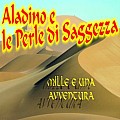Aladino e le Perle di Saggezza — 21 of 49
Leonardo Boselli
Section 5 - Il vecchio saggio
The vecchio saggio is a man in the oasi. "Vedi anche un vecchio [o]saggio[x] che dorme all[']ombra di una palma, con la schiena appoggiata al [o]tronco[x]. E['] molto anziano e le rughe del suo volto trasudano saggezza. Deve conoscere molte cose." The description is "Il vecchio saggio sonnecchia."
Instead of giving something (called the object) to the vecchio saggio:
say "Il vecchio non ha preso [the object]."
The tronco di palma is a scenery in the oasi. The description is "[mostra-palme]A giudicare dal tronco, la palma è vecchia quasi quanto il saggio. Che abbia sempre dormito appoggiato qui?".
The tappeto afghano is a cosa-calpestabile. The keyword is "tappeto". The tappeto afghano is in the oasi. "Il vecchio saggio è seduto su un [o]tappeto[x] afghano originale. Deve essere veramente comodo a giudicare da come ci dorme sopra saporitamente." The description is "[mostra-tappeti]Un tappeto afghano originale[if the player does not wear a paio di sandali]. Salire sul tappeto deve essere un vero sollievo per i piedi[end if]."
Instead of taking a cosa-calpestabile (called the portante) when the cosa-calpestabile supports something (called the portato):
say "Prima di prendere [the portante] devi togliere [the portato]."
After entering the tappeto afghano:
say "[mostra-tappeti]Sali sul [o]tappeto[x] afghano e pensi: 'E['] molto comodo![no line break]'[if the under#tappeto contains something], ma fatto un passo senti che c[']è nascosto sotto qualcosa.[otherwise][line break][end if]"
After touching the tappeto afghano:
say "[mostra-tappeti]Tocchi il [o]tappeto[x] afghano e pensi: 'E['] veramente soffice![no line break]'[if the under#tappeto contains something], ma al tatto senti che c[']è nascosto sotto qualcosa.[otherwise][line break][end if]"
Before doing anything except taking inventory or looking or examining or exiting or getting off or entering when the player is on a cosa-calpestabile (called the tappeto):
say "(prima scendi [dap the tappeto])";
try silently exiting;
continue the action.
Before entering a cosa-calpestabile (called the arrivo) when the player is on a cosa-calpestabile (called the partenza):
if the arrivo is not on the partenza:
say "(prima scendi [dap the tappeto])";
try silently exiting;
continue the action.
An underside called under#tappeto is part of the tappeto afghano. The bulk capacity of the under#tappeto is 5.
The paio di sandali is a wearable thing. The paio di sandali is in the under#tappeto. The description is "Un comodo paio di sandali." The printed name is "paio di [o]sandali[x]".
After looking under the tappeto afghano for the first time:
award 15;
continue the action.
Instead of going somewhere when the player does not wear the paio di sandali and the oasi is visited:
say "Prima di camminare, pensi: 'E['] stupido ferirsi ancora i piedi quando potrei appoggiarli su qualcosa di soffice[if the player carries the paio di sandali] o, addirittura, calzarli con questo bel paio di [o]sandali[x] che ho in mano[end if].'"
Understand "calza" as wearing.
Instead of taking the tappeto afghano:
say "Non puoi prenderlo [scopri-afghano]".
Instead of pulling the tappeto afghano:
say "Non puoi tirarlo [scopri-afghano]".
To say scopri-afghano:
say "[mostra-tappeti]perché c[']è il vecchio saggio seduto sopra.[if the under#tappeto contains something]Nel tirarlo, comunque, ti accorgi di un rigonfiamento e pensi: 'Che ci sia sotto qualcosa?'[end if]".
After putting something (called the nascosto) on an underside (called the sottotappeto):
say "[mostra-tappeti]Hai nascosto [the nascosto] sotto [ap the sottotappeto]."
A puzzle is a kind of thing. A puzzle can be risolto or mescolato.
The cubo di Rubik is a puzzle. The keyword is "cubo". The cubo di Rubik is mescolato. The printed name is "[o]cubo[x] di Rubik".
The cubo di Rubik is in the under#tappeto. The description is "Il mitico cubo di Rubik! [if the cubo is mescolato] E['] mescolato e pensi: 'Chissà se sono ancora capace di risolverlo!'[otherwise] E['] già risolto e pensi: 'Chissà se sarei ancora capace di risolverlo, dopo averlo mescolato.'[end if]".
Mixing is an action applying to one thing.
Solving is an action applying to one thing.
Understand "risolvi [something]" or "risolvi [art-det] [something]" or "risolvi [a known thing]" as solving.
Understand "mescola [something]" or "mescola [art-det] [something]" or "mescola [a known thing]" as mixing.
Check mixing something (called the cubo):
if the cubo is not carried by the player:
say "Non hai in mano [the cubo]." instead;
otherwise if the cubo is not a puzzle:
say "[The cubo] non si può mescolare." instead.
Check solving something (called the cubo):
if the cubo is not carried by the player:
say "Non hai in mano [the cubo]." instead;
otherwise if the cubo is not a puzzle:
say "[The cubo] non si può risolvere." instead.
Carry out mixing something (called the cubo):
if the cubo is mescolato:
say "E['] già mescolato, ma rimescolarlo ancora non fa male.";
otherwise:
say "Mescoli [the cubo] con cura.";
now the cubo is mescolato.
Carry out solving something (called the cubo):
if the cubo is mescolato:
now the cubo is risolto;
say "In meno di dieci secondi risolvi [the cubo]. Nell[']ammirarlo pensi: '[one of]E['] come cavalcare un cammello: certe cose non si dimenticano[or]Nonostante siano passati anni, sono sempre in gamba[at random].'";
otherwise:
say "E['] già risolto!".
